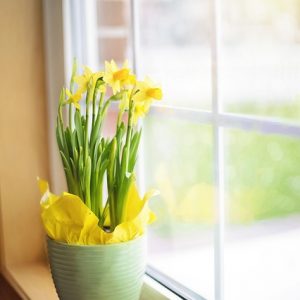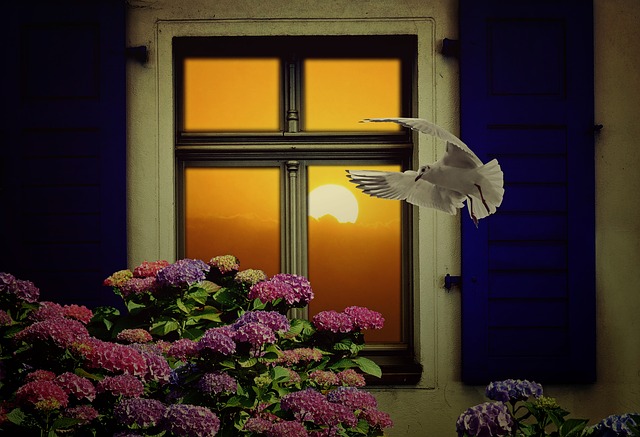11 Ways to Prevent Birds From Flying Into Windows
The sound of a bird, no matter how big, flying into your closed window can be quite startling. It can also lead to broken windows and inevitably, a few fallen birds. While keeping blinds and curtains closed at all times is effective at keeping birds at bay – most homeowners want to be able to look out the window from time to time! Fortunately, there are many ways to prevent birds from hitting your windows that still allow you to see out the window.
Let’s take a closer look at how to keep birds from hitting windows.
Why Do Birds Fly Into Closed Windows?
To start, it helps to understand why certain birds like robins and cardinals seem to aim straight for your closed windows. These birds are simply seeing a continuation of their habitat (more trees and open sky) reflected in your window. Some species might also be mistaking their own reflections for other birds and go in for the attack.
To prevent broken windows in your future, and to perhaps spare a few birds’ lives in the process, Budget Glass Nanaimo has a few tips for bird proofing your windows – the bulk of these methods involve obscuring their reflection.
1. Paper Cut-outs of Birds
One cost-effective way of bird proofing your windows is to hang up paper cut-outs of other birds in the window. You can make these out of ordinary computer or construction paper. Not so into the DIY? Pet stores sell decals that are colored in an ultraviolet spectrum. These decals are transparent to human eyes but visible to birds.
2. Stained Glass or Other Adhesive Decals
If birds aren’t your thing, consider dressing up the window a little bit with other types of obstructions, like stained glass art pieces, or other window decorations, like the reusable plastic decals found at most home décor shops, dollar stores, or craft stores. Even something as simple as multiple Post-It Notes will do the trick.
3. Films
Window films are fairly inexpensive and are applied like wallpaper to the exterior of the window to reduce reflection. Window films help protect your windows and the birds while making your windows more energy efficient at the same time.
One type of DIY window film we’ve heard people trying is dish soap, which, when thinly spread, creates an opaque film on the window. However, this type of film would need plenty of reapplications. Another approach is using window paint as a type of window film, which could be a fun project for the kids.
5. Window Treatments
A more permanent measure is installing manufactured glass such as UV-patterned glass or acid-etched glass – two types of commercially produced glass treatments. UV patterned glass is a glazing treatment that birds can see but humans cannot, which keeps your windows transparent and also helps with energy efficiency. Acid-etched glass obscures the transparency of the windows for both humans and birds. With this method, a chemical is used to etch a pattern or full opaque treatment onto the window. Acid-etched glass acts like film but is more durable and won’t scratch off.
6. Adhesive Stripes
Rather than decals, vertical stripes might be more of the aesthetic you’re looking for. We recommend using 1/8″ window-safe white tape on the outside of the window spaced about four inches apart. You can also use black electrical tape in a pinch. There is also a specialty tape available at pet stores designed for this purpose, or you can use paint pens and stencils.
9. Bird Feeders & Baths
In addition to adjusting your windows, pay attention to what you have around your windows, such as bird feeders and baths. One approach is to keep feeders and baths far from your windows (more than 25 feet) so birds end up avoiding your windows altogether.
Alternatively, hang feeders very close to your windows. The feeders will draw birds in slowly, lessening the chance of them hitting your window at full speed. This principle also works with wind chimes.
7. Netting, Screens, and Shutters
Beyond obstructing window reflections, you can also install physical barriers like thin dark netting, bird-safe screens, or shutters. All of these physical barriers can be customized to your window size and type, making them aesthetically pleasing. Sunshades and awnings also help reduce window reflections by shading the area.
8. Lighting
Exterior lighting can have an effect on birds and other wildlife and should be adjusted accordingly, starting with ensuring exterior lights are shielded downwards. Next, go for motion sensor lights to keep overall lighting to a minimum, and choose the wattage of your exterior light bulbs wisely to avoid over lighting. Warm-light LEDs are optimal.
Also try to keep interior lights off as much as possible so birds aren’t drawn to your home at dusk when the natural light starts to fade.
9. Plant Life
We have seen a few homeowners attach branches or small pieces of driftwood to the exteriors of their windows using suction cups and fishing line. This artistic approach gives birds something to perch on and draws birds in slowly enough so that they get what they are looking for without divebombing the window.
You can also plant trees and hedges or planter boxes near your windows to obstruct the view and also add privacy to your space.
If you have houseplants, consider moving them away from the window.
10. New Windows
When it comes time for installing new windows, talk to your window installers about your concerns about birds. Slightly tilted windows may be an option. When windows are installed at a slight vertical tilt facing downward, the window surface reflects the ground, rather than the sky and the trees. The tilt is subtle enough that homeowners don’t notice it.
11. Consult the Pros
If you need help solving the problem of birds hitting your window, the glass specialists at Budget Glass Nanaimo can help. To learn more about our specialized glass, window films, and windows for homes and businesses, give us a call at (250) 758-3374 or schedule an appointment online.

